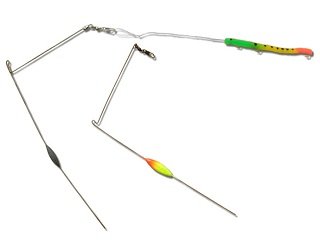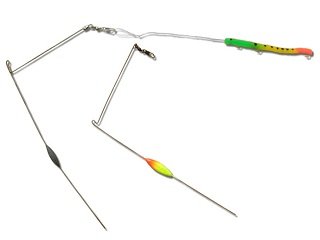 There are times when conditions on the water require what some may call a less than exciting approach in order to put fish in the boat. To such critics, trolling is such an approach. However, if your aim is to fill your boat with trophy walleye, then sometimes trolling with a bottom bouncer is the way to go. These little beauties do a great job of keeping your bait at the bottom when fish hold there. Keep reading to learn how to effectively utilize bottom bouncers the next time you head out to fish the bottom.
There are times when conditions on the water require what some may call a less than exciting approach in order to put fish in the boat. To such critics, trolling is such an approach. However, if your aim is to fill your boat with trophy walleye, then sometimes trolling with a bottom bouncer is the way to go. These little beauties do a great job of keeping your bait at the bottom when fish hold there. Keep reading to learn how to effectively utilize bottom bouncers the next time you head out to fish the bottom.
Certain species of fish congregate near the bottom during specific times of the year, when casting is difficult. Trolling is effective for such species, but lures are nearly impossible to use near the bottom without snagging on structure, rocks, or vegetation. This is where bottom bouncers come into play. Their purpose is to keep the bait at the bottom, when fish situate there, while trolling. This is accomplished through their design, which implements a bent piece of heavy duty wire that possesses a weight. The wire is usually bent into an acute angle, with the weighted end pointed towards the bottom and the opposite end trailing behind, where you’ll attach the bait to a swivel on the tip. While trolling with a bottom bouncer, the weighted end will keep the bait at the bottom while bouncing over structure, but still allow the bait to trail behind it.
Once you’ve picked up a few bottom bouncers, the next step is to grab a few basic pieces of additional tackle to complete the setup. Attach a swivel to the empty end and then attach a snell to that. You can use a bare snell, but ones that are equipped with spinners are preferred by anglers for their action in the water. Shorter snells work best, as longer ones will move around more, thus making them more prone to snag. Just be sure to use one with lighter line than what’s on your reel. This way, if it does get snagged, you’ll only lose the snell, and not the bouncer. Also, a live bait floater isn’t a bad idea, as these keep your bait from dragging along the bottom.
Choosing the appropriate weight is a vital part of bottom bouncing. One rule I’ve been told is this: one ounce per ten feet. For instance, when fishing ten feet of water, you’d want to use a bottom bouncer with a one-ounce weight. For twenty feet, use two-ounce, and so on.
Finally, how much line you have in the water when using a bottom bouncer is an important factor. You really don’t want the angle of your line to be greater than 45 degrees, as too much line will significantly alter the angle at which your bouncer comes into contact with the bottom.
When walleye are holding at the bottom, using a bottom bouncer is the best way to get your bait in the strike zone and keep it there. Some may not consider it to be the most engaging tactic, but it gets the job done. Sometimes, a slower, more methodical approach is necessary when putting fish in the boat is top priority.








